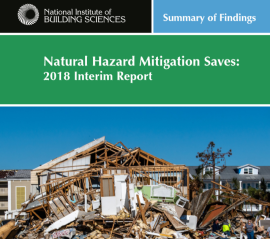“Pre-disaster mitigation—preparing in advance for future disasters—better assures that hazardous events will have short-lived and more manageable outcomes. Mitigation saves lives, preserves homes, businesses, government facilities, utilities, and transportation infrastructure. It reduces damage to belongings; reduces the need for temporary shelter; helps economies to spring back faster, and lowers recovery costs. At the same time, investing in mitigation invigorates the economy through increased construction—whether the funding comes through federal or state programs, or through privately financed retrofits and new construction.
Building on the goals of the 2005 Mitigation Saves study, this report, Natural Hazard Mitigation Saves: 2018 Interim Report, shares the results from the second of a multi-year project. The purpose of this new study is to help decision-makers to build a mitigation strategy so they can protect lives, property, and assets. The findings are intended to inform future code changes to make communities more resilient, help jurisdictions make decisions on what codes to adopt and enforce, and assist policymakers in developing effective federal programs that support predisaster mitigation. This report and the underlying study represent the work of an expert project team, which was vetted by equally qualified oversight committees and received feedback from building industry stakeholders and federal government reviewers, all of which are acknowledged at the end of the report.” -National Institute of Building Sciences
